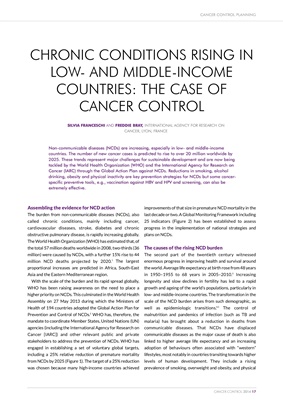
CANCER CONTROL PLANNING
18 CANCER CONTROL 2014
inactivity; the major risk factors for the most common NCD
types: cancer, cardiovascular diseases, stroke, diabetes and
chronic obstructive pulmonary diseases.
Comparing the NCD burden and priorities
In a number of high-income countries (e.g., Australia, Canada,
France, Italy, Spain, Norway, Sweden, Switzerland, Israel,
Japan and the Republic of Korea), life
expectancy at birth now exceeds 80
years. Perhaps contrary to common
perception, the more highly developed
regions of the world do not exhibit the
highest age-standardized death rates of
NCDs (Group II in Figure 3).3 If the
underlying population age structure
was equal - as seen by comparing
the age-standardized and nonstandardized (crude)
death rates in
Figure 3, Africa would have the highest
NCD mortality worldwide, in relative
terms. It is therefore essential to bear in
mind that low- and middle-income
countries often experience a "double
burden" of disease: still rather high
death rates of infectious diseases
alongside a high and ever-increasing
burden from the major NCDs (Figure 3).
There are different ways to establish
priorities and achievable targets in the
prevention of NCDs and the focus of
WHO has been on common, modifiable
risk factors shared across the
spectrum of key diseases (Figures 1 and
2). In addition, high-priority medical
interventions had to be feasible and
potentially cost-effective in primary
care settings in any country, i.e., socalled best-buys.6
Obviously, best-buys
vary markedly from one country to
another according to the variable
impact of different NCDs and, in
particular, individual cancer sites.
Cancer: A multifaceted disease
and a major cause of death
Cancer is a complex disease with its
own epidemiological transition: as
countries move towards high levels of
human development, cancers associated with infection and
poverty (e.g. cancers of the stomach, liver and cervix) are
surpassed in their magnitude by those more associated with
affluence (e.g. cancers of female breast, prostate and colon).
In high-income countries, the control of infectious disease
and the lowering of death rates of cerebrovascular disease
and stroke, have led to cancer becoming increasingly one of
Drug therapy
and counselling
50% coverage
Essential NCD
medicines and
technologies
80% coverage
Diabetes/
obesity
0% increase
Raised blood
pressure
25% reduction
Tobacco use
30% reduction
Salt/sodium
intake
30% reduction
Physical
inactivity
10% reduction
Harmful use
of alcohol
10% reduction
Premature
mortality from NCDs
25% reduction
Set of 9 voluntary global NCD targets for 2025
Formal meeting of Member States to conclude the work on the comprehensive
global monitoring framework including indicators and a set of voluntary targets
for the prevention and control of NCDs (Geneva, 5-7 November 2012)
Mortality and morbidity
Risk factors for NCDs
National system response
Figure 1: Voluntary global NCD targets for 2025
Source: World Health Organization
The NCD Alliance: Putting non-communicable diseases on the global agenda. (http://ncdalliance.org/campaigns)
Formal meeting of Member States to conclude the work on the comprehensive
global monitoring framework including indicators and a set of voluntary targets
for the prevention and control of NCDs (Geneva, 5-7 November 2012)
Global monitoring framework
Harmful use of alcohol (3)
Low fruit and vegetable intake
Physical inactivity (2)
Salt intake
Saturated fat intake
Tobacco use (2)
Raised blood glucose/diabetes
Raised blood pressure
Overweight and obesity (2)
Raised total cholestrol
Risk factors
25 Indicators
Total number of related indicators in brackets
Cervical cancer screening
Drug therapy and counseling
Essential NCD medicines
and technologies
Hepatitis B vaccine
Human Papilloma virus vaccine
Marketing to children
Access to palliative care
Policies to limit saturated
fats and virtually
eliminate transfats
National system response
Unconditional probability
of dying between ages 30 and 70
years from cardiovascular
diseases, cancer, diabetes or
chronic respiratory diseases
Cancer incidence by type of Cancer
Mortality and morbidity
Figure 2: Global monitoring framework
Source: World Health Organization.
The NCD Alliance: Putting non-communicable diseases on the global agenda. (http://ncdalliance.org/campaigns)